Content
- 1 What are the varieties of honeysuckle
- 2 The sweetest varieties of edible honeysuckle
- 3 Early honeysuckle varieties
- 4 Late varieties of honeysuckle
- 5 Low-growing honeysuckle varieties
- 6 Tall varieties of honeysuckle
- 7 New varieties of honeysuckle with large berries
- 8 Non-crumbling varieties of honeysuckle
- 9 Elite varieties of honeysuckle
- 10 Winter hardy varieties of honeysuckle
- 11 Conclusion
Honeysuckle varieties with a description should be studied by anyone who wants to plant a plant with sweet fruits on the site. Edible culture is presented in a very diverse selection.
What are the varieties of honeysuckle
There are dozens of varieties of edible honeysuckle suitable for cultivation in Russia. For convenience, they are divided into several groups:
- according to the level of frost resistance, some shrubs are better to grow in the middle lane, others tolerate the conditions of Siberia well;
- in terms of ripening - honeysuckle is early, medium ripeness and late;
- in size, some plants bear small berries, others are distinguished by large fruiting;
- in taste - honeysuckle is sweet-dessert, with sourness, with a bitter aftertaste;
- by resistance to shedding - in some varieties the berries fall to the ground very quickly, in others they stay on the branches for a long time;
- in height, the size of the honeysuckle shrub is important when organizing the landscape.

Most often, the plant is chosen for its sweet dessert taste.
The sweetest varieties of edible honeysuckle
When planting an edible crop on the site, most gardeners tend to enjoy really tasty fruits. You can look at the ranking of honeysuckle varieties with a particularly sweet taste.
Azure
The plant is mid-ripening, the fruits on its branches ripen towards the end of June. Honeysuckle Azure rises up to 1.3 m above the ground, the bush is quite compact, compressed, the leaves are elongated with a solid edge.
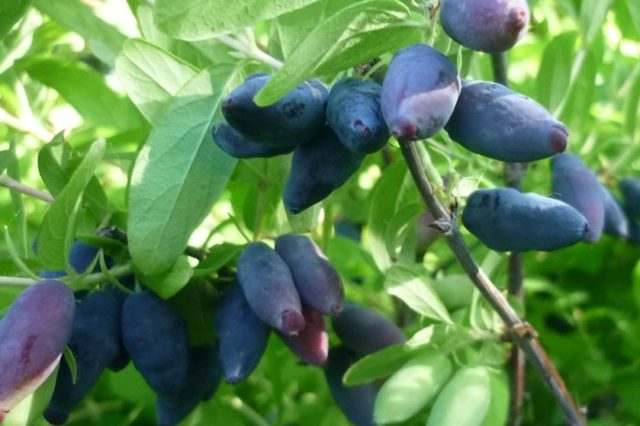
Azure - one of the most delicious types of edible honeysuckle
The tasting score of the Lazurnaya honeysuckle variety is 5 points, this is the maximum indicator. The dark blue, almost purple berries exude a pleasant blueberry aroma, very sweet in taste. The berries are oval in shape, with a sharpness in the upper part. In a favorable season, Lazurnaya can bring up to 5 kg of harvest from one bush.
Ramenskaya
Honeysuckle of this variety grows up to 1.5 m in height and can spread about 1 m. Ripening occurs by the end of June, Ramenskaya brings elongated dark blue berries with a slight pubescence and bluish bloom.
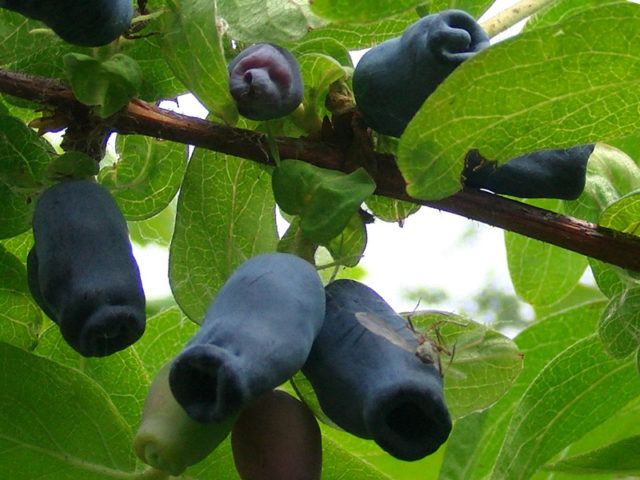
Ramenskaya has a refreshing taste
Ramenskaya's pulp is sweet, but it has a slight sourness, so the tasters give it a rating of only 4.5 points. The maximum yield of the bush is just over 2 kg.
Kingfisher
Among the sweetest varieties of honeysuckle without bitterness, Kingfisher is worth mentioning. In height, the shrub can reach 2 m, usually spreads no more than a meter in diameter. Fruiting at the end of June, Kingfisher bears large oval-rounded berries of a dense blue color. Kingfisher's skin is thin, covered with a blue bloom, the flesh does not have a smell.
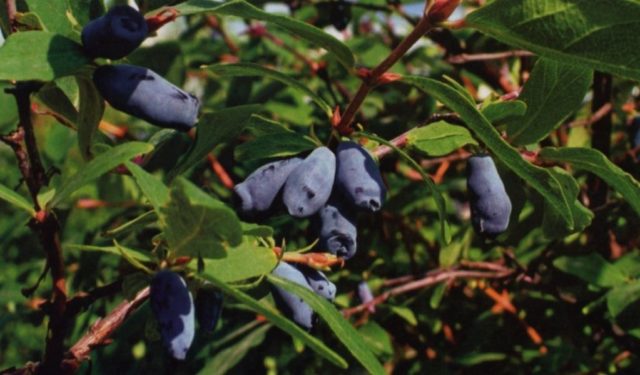
There is absolutely no sourness or bitterness in Kingfisher
The kingfisher is estimated at 4.8 tasting points, the taste of the berries is soft, sweet, without sourness and bitterness. Honeysuckle berries refresh well. Approximately 2 kg of ripe berries can be removed from an adult plant bush.
Early honeysuckle varieties
Honeysuckle is considered early, with May flowering and fruiting between June 10 and 20. Such varieties are especially appreciated because they allow you to enjoy the taste of the fruit already at the beginning of summer.
Yoke
The growth of the shrub is usually 1.2 m, Koketka bears harvest in the second decade of June. Koketka's berries are oval-elongated, blue in color, with a light light bloom. To the taste, the pulp is very tender, with a good sweet and sour taste and a rating from the tasters of 4.3.
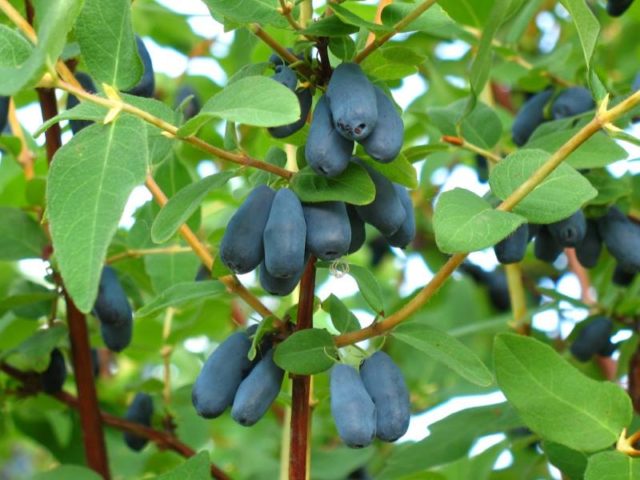
You can try the harvest from Koketka by mid-June
The volume of the shrub yield is about 1.4 kg. The coquette is suitable for use in any form, but it is especially good when fresh.
Altair
In terms of growth, the plant rises by 1.5 m, bears fruit around June 15-20. Altair's fruits are oval and elongated, deep blue with a pronounced waxy bloom and smooth, dense skin.
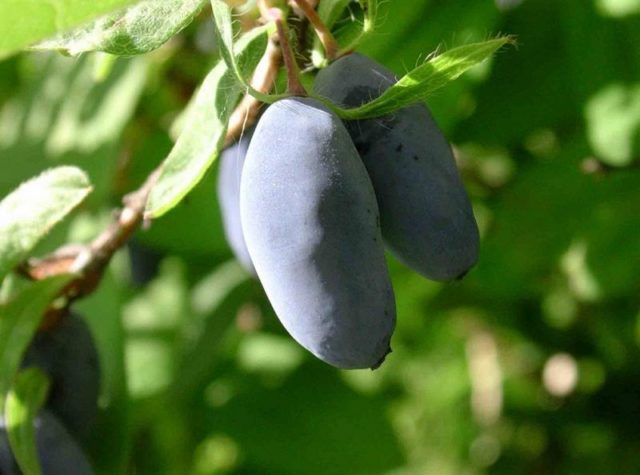
Altair may bear fruit before June 20
The pulp of Altair honeysuckle is dense, with a weak aroma, sweetish-sour taste. The variety deserves a tasting rating of 4.4, it is eaten fresh and is made from berries. Up to 2 kg are harvested from one shrub.
Moraine
The shrub of this variety is considered medium-sized and reaches about 1.5 in height. Morena's berries are rather large, elongated-cylindrical, with a slightly bumpy surface. The color of the berries is blue, dark, thin skin is covered with an abundant waxy bloom. The fruits ripen by June 20, which gives grounds to consider Morena an early plant.
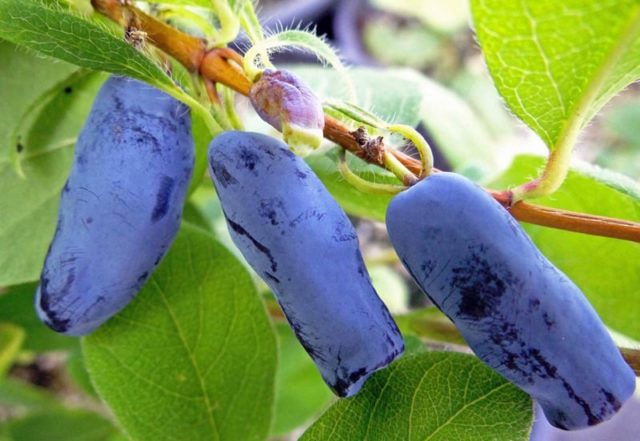
Morena - early ripening variety
The Morena pulp exudes a pleasant delicate aroma, is distinguished by a sour-sweet aftertaste, on a five-point scale it is estimated at 4.5 in terms of dessert qualities. Average yields of up to 2.5 kg are obtained from the bush.
Late varieties of honeysuckle
Honeysuckle is late, the fruits of which ripen in June closer to the 30th. Such plants are valued for the dessert taste of berries, gourmets note that late honeysuckle is usually sweeter.
Amphora
In height, the Amphora bushes rise by 1.5 m, and ripening occurs in the last days of June. The fruits of Amphora bear large and massive, up to 3 g in weight, jug-shaped with a smooth skin. By color, the berries are bluish-blue, with a noticeable bluish bloom.
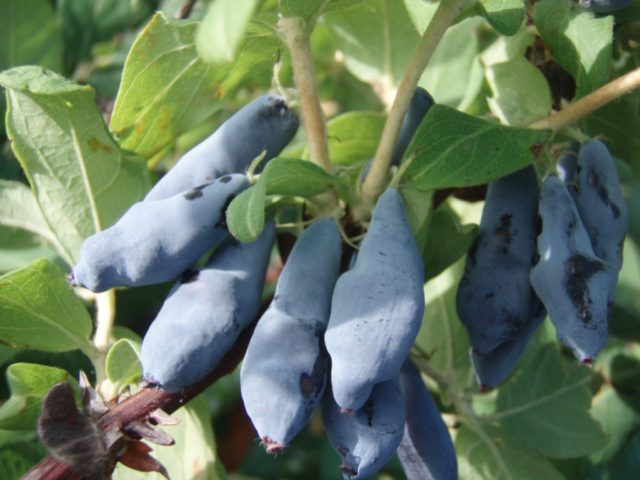
Amphora matures late and tastes very good.
The pulp of Amphora has no aroma, is dense in consistency, with fibers. The pulp has a pleasant taste - mostly sweet, with subtle sour and bitter notes. On the palate, you can notice a lingonberry shade. The tasting score is 4.5, the yield of Amphora is estimated as high - up to 2 kg per bush.
Lenita
A tall variety up to 2 m tall yields a crop after June 25. Lenita's berries are large, elongated and pitcher-shaped, blue in color. One adult plant on the site is capable of producing more than 3 kg of berries, and this figure is considered above average.
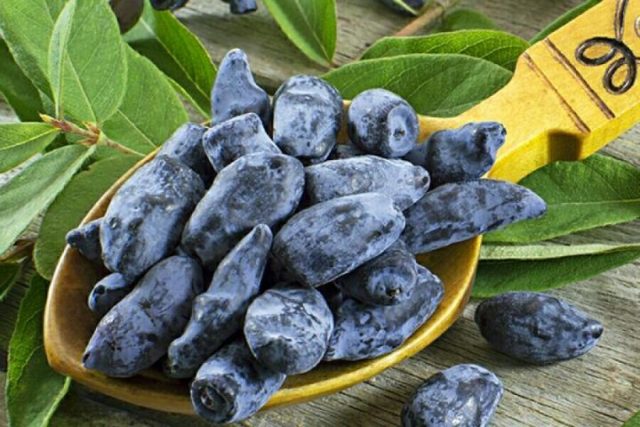
Lenita is not only tasty, but also a high-yielding species
Lenita's tasting score is 5 points, the taste is sweet with a slightly noticeable bitterness. The purpose of the berries is universal, when ripe they stay on the branches for a long time.
Nymph
Nymph is a tall variety, capable of reaching 2.5 m. The plant bears fruit at the end of June, spreads slightly, bears large fruits up to 1.9 g of a fusiform shape. The color of the berries is blue-bluish, the surface is bumpy.
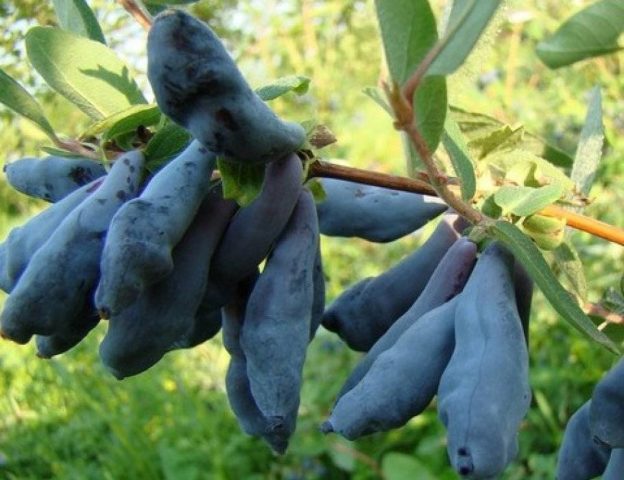
Nymph berries are similar in shape to a spindle
The taste of Nymph is very sweet; the rating of its dessert qualities is 4.7. Light astringency is felt in the taste. Nymph's yield is moderate, on average 1.3 kg per plant.
Low-growing honeysuckle varieties
Gardeners appreciate low-growing shrubs for the fact that it is very convenient to harvest from such plants. Even the top fruits can be reached without using a stool or ladder.
Gzhel late
The shrub usually rises no more than 1.5 m above the ground. It bears large pear-shaped fruits, dark blue in color, with slight pubescence on the skin. This variety can be harvested at the end of June.
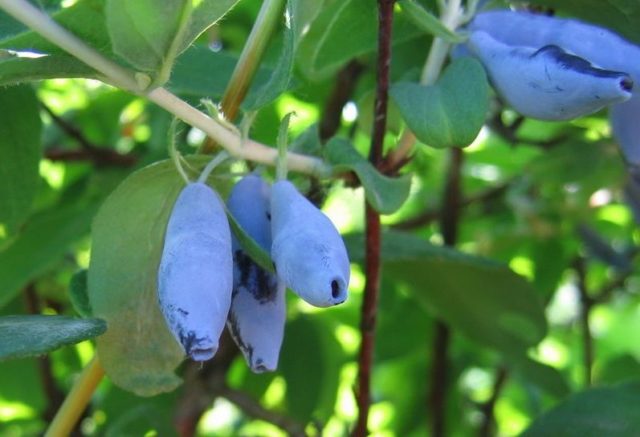
There is a noticeable sourness in the taste of Gzhel late
Gzhelskaya late deserves a tasting rating of 4.8 and has a sweet, slightly sour taste. The weight of the berry is on average 1.1 g, and the yield of the shrub is 2 kg per adult plant.
Yulia
The mid-ripening variety rises up to 90 cm above the ground surface, bears elongated oval fruits with a small mass in mid-June. At the top they have a small roller, the color of the berries is blue with a bluish bloom.

Julia's honeysuckle can be consumed in any form
The taste of the Julia variety is sweet, the berries are given a score of about 4.5 according to a five-point scheme. Yulia's yield is low, a little more than 1 kg from a particular shrub. Berries are suitable for any use, often used in desserts.
Gourmet
A short shrub about 1.4 m tall bears fruits of an elongated shape, with a dark blue skin, covered with a characteristic bloom. Their weight is average, with just one plant it will be possible to collect up to 3 kg with good care.
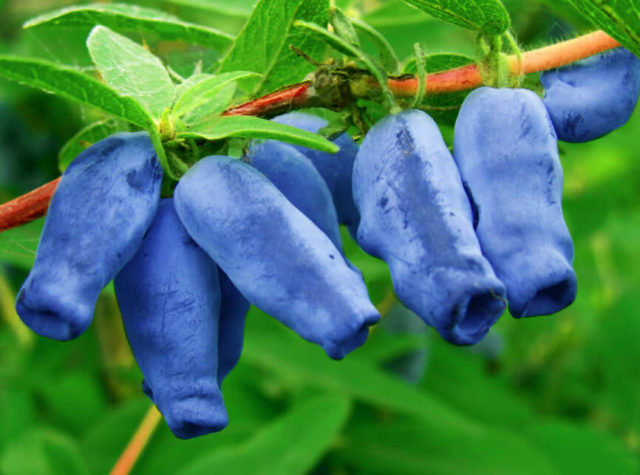
Gourmet is fully true to its name
The tasting score assigns 4.9 points to Lakomka, the taste of the pulp is sweet with a slight sour note, completely without bitterness. This variety can be harvested in mid-June.
Tall varieties of honeysuckle
High honeysuckle is appreciated by gardeners for its good decorative qualities. When planting on the site, you can not only collect delicious fruits, but also use the shrubs as part of art groups. In addition, high-yielding varieties of honeysuckle are more often observed among vigorous shrubs.
Bakcharskaya
A tall bush rises up to 1.7-2 m above the ground, has a thick and wide crown. The berries of the variety are bluish-blue, drop-shaped in shape with a small apical roller, by weight about 0.7 g. The surface of the skin is slightly bumpy, the skin itself is dense.
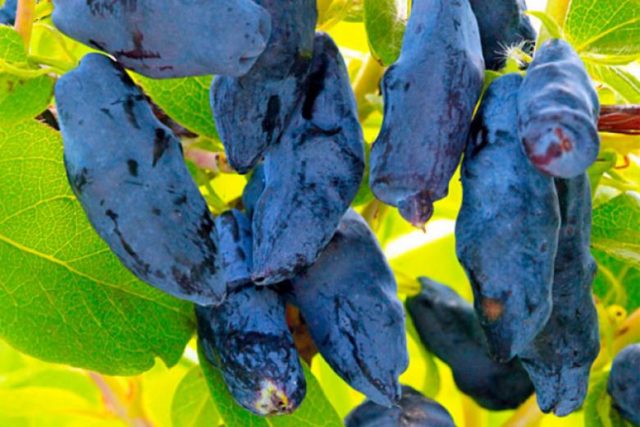
Bakcharskaya has a slight bitterness, although it remains tasty
Bakchar honeysuckle is tasty and sweet, but there is a distinct bitterness in it, so the variety is estimated in terms of dessert qualities at only 4.2. Ripening occurs at the beginning of July. With good care, you can get about 3.8 kg of yield from one bush.
Fortune
A tall shrub with a rounded compact crown can rise up to 2 m above the soil. Fruiting occurs early, by mid-June, Fortuna's fruits are cylindrically elongated, dark blue almost to black.
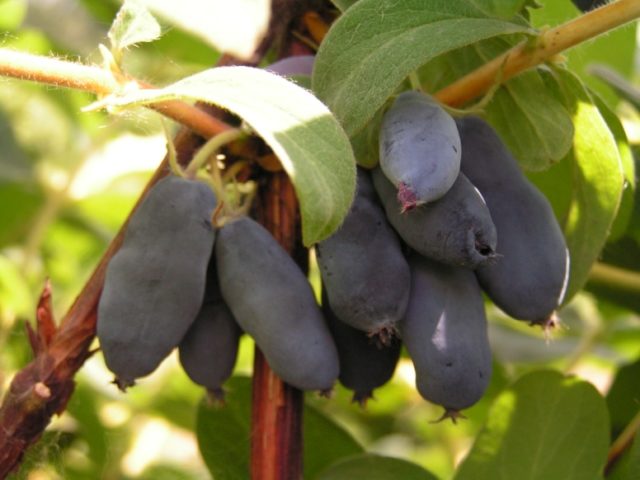
Fortune brings dense thickened berries
Fortuna has a pleasant taste, but with a slight sourness and astringency, so the tasting rating is 4.5. The bush brings average yields, the purpose of the fruits is universal.
Moscow-23
The height of the shrub can reach 2.5 m, the harvest from Moskovskaya-23 is harvested closer to June 20. The fruits of the variety are large, elongated, almost black in color with a waxy bluish bloom. The average fruiting in the bushes is high, in the region of 3.5 kg.
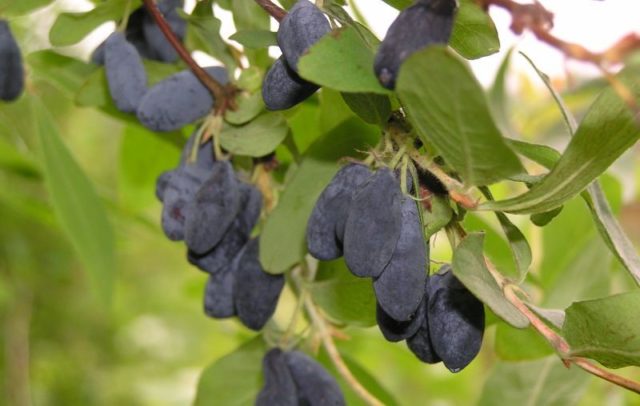
Moskovskaya-23 - sweet and sour look with light tart notes
The taste of Moskovskaya-23 is quite pleasant, sweet-sour, but with a noticeable astringency. The pulp is fibrous, the variety is completely unsuitable for transportation, since it crumples a lot. The fruits of Moskovskaya-23 are estimated at only 3.9 points.
New varieties of honeysuckle with large berries
Most of the old varieties of edible honeysuckle bear fruit with a small weight, about 1 g. But in recent years, breeders have bred varieties that give more massive berries. In comparison of varieties of honeysuckle, several varieties take leading positions.
Strezhevchanka
Tall honeysuckle rises up to 2 m and has a sparse crown. Fruits early, the berries are very large - up to 2.7 g. In color, the fruits are almost black, with a bluish bloom, their skin is thin. The berries ripen at the same time, and up to 4.5 kg per plant can be harvested in one season.
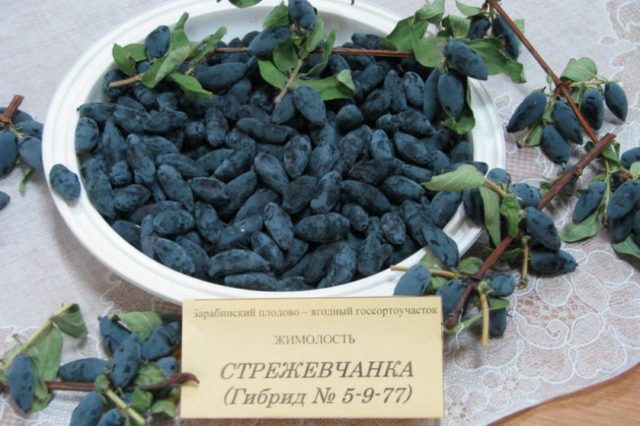
Strezhevchanka was bred in 2012 and has already earned good marks
Strezhevchanka's flesh is tender, sweet and sour in taste; the grade was assigned a score of 4.8 during tasting. The variety was bred only in 2012, but is considered very promising.
Delight
A tall shrub of about 1.8 m, bred in 2012, has straight branches and a thin crown, which makes it seem very decorative. The mass of the fruits of Delight is up to 2.8 g, the color of the berries is dark purple with a bluish tinge. The variety ripens early, until mid-July, and the berries are easily separated from the branches. From one bush, Delight, you can collect as many as 5.5 kg of ripe fruits.
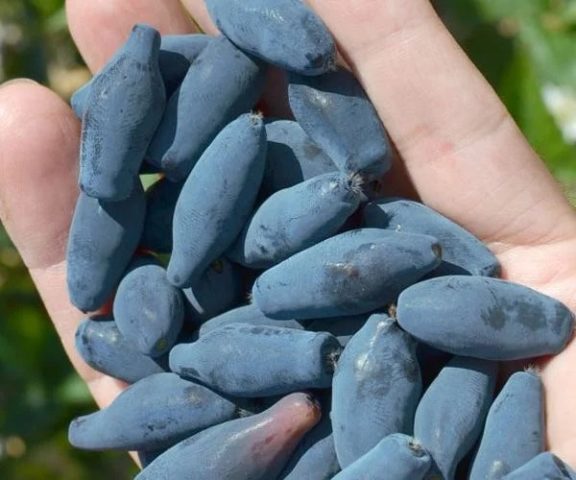
Delight is the new sweet and fruitful honeysuckle
Delight refers to varieties of large and sweet honeysuckle. It was awarded a score of 4.8 by the tasters.
Borealis
The 2007 variety belongs to the category of undersized and does not exceed 1.2 m in height. Borealis berries are oval, medium in weight. The tasting grade is 4.8, because the fruit is very sweet with a pleasant astringency.
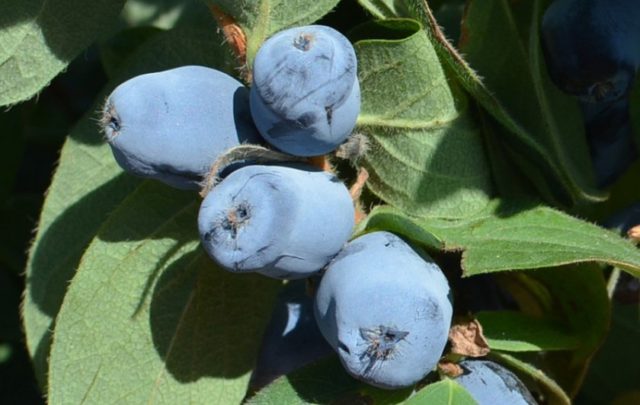
Borealis is a newly bred sweet-tasting variety
The berries are bluish-purple in color, juicy and soft. The yield of a plant is average, Borealis can rarely bring more than 2 kg from a particular plant.
Non-crumbling varieties of honeysuckle
Many varieties of edible honeysuckle have a common disadvantage - after ripening, the fruits begin to crumble from the branches, which is why part of the harvest is lost. However, there are varieties that do not have this disadvantage.
Titmouse
The height of the plant is about 1.5 m, the titmouse bears fruits in the early stages. Under good conditions, the bush can produce up to 5 kg of berries - elongated, cylindrical, dark blue. Titmouse's pulp is very aromatic and tasty, sweet-sourish, but fibrous. The official score from the tasters is quite high, it is equal to 4.7.

Titmouse, upon reaching ripeness, does not begin to crumble
It is better to use the harvested crop fresh, it will not be able to be stored for a long time. But on the other hand, when ripe, the Titmouse does not crumble and is suitable for simultaneous collection.
Pavlovskaya
The medium-sized wide bush rises 1.5 in height and bears blue, purple-tinged fruits, oval with a taper at the top. The yield of the variety is low, and the fruits themselves are small in weight, but quite tasty - sweet with sourness, with an estimate of 4.4 points.
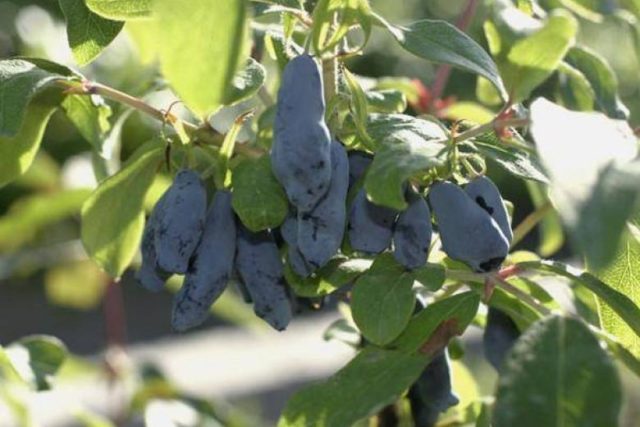
Pavlovskaya stays on the branches for a long time after ripening
Pavlovskaya bears fruit in mid-June and does not crumble for a long time. Honeysuckle keeps well and is therefore suitable for any application.
Malvina
The height of the honeysuckle is about 1.7 m, the variety ripens in the second decade of June. Malvina fruit bears medium size and weight, blue-blue color, slightly lumpy and elongated.
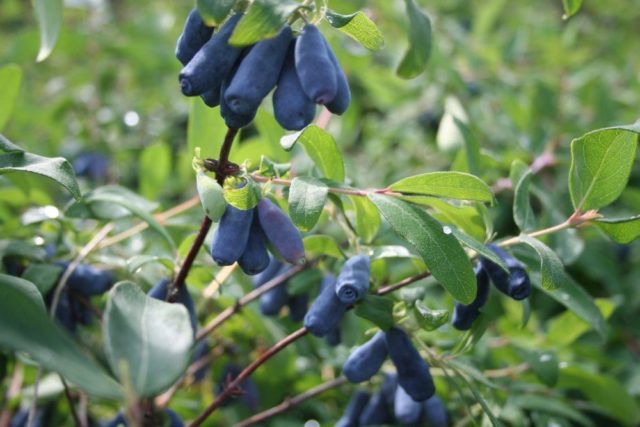
Malvina is a very juicy variety with a sour-sweet taste
Malvina's pulp has almost no aroma, but juicy and sweet with sour notes. Estimated by tasters at 4.4. Malvina berries are not stored for a long time, however, they hold well on the shoots and do not crumble after ripening.
Elite varieties of honeysuckle
Some varieties of edible honeysuckle are considered to be truly elite. They are highly regarded for their dessert qualities, as well as for their increased endurance and good yield.
Yugan
A fairly young variety, introduced in 2010, has already made it to the list of the best. The Yugan variety ripens late, at the end of the first summer month, reaches 1.5 m in height. Fruits in dark purple, pitcher-shaped berries with an almost black tint.
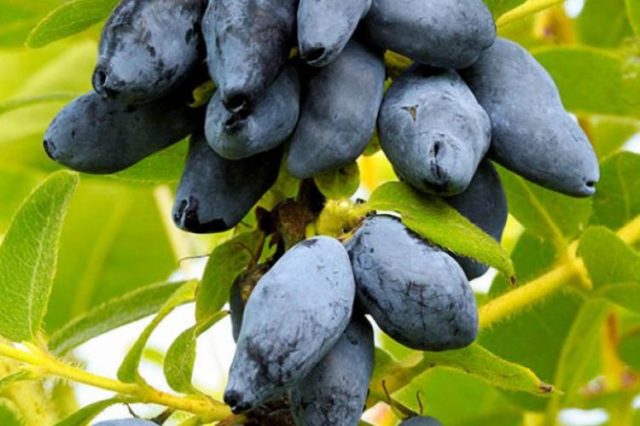
The Yugan variety can be considered elite, it is high-yielding and dessert in taste.
Yugan tastes sweet, with a rating of 4.9.The plant has a high yield, up to 6 kg per plant, bears fruit stably and is not prone to shedding.
Volkhova
The Volkhova variety, which ripens on the 20th of June, deserves high marks. A tall shrub can rise up to 2 m, its berries are small, but very tasty, sweet and with a pleasant strawberry aroma. The tasters' score is 4.7.

The Volkhov variety has small berries, but sweet
The Volkhov shrub is appreciated not only for its good taste, but also for its winter hardiness and resistance to diseases. The variety is moderately fruitful; in good conditions it gives more than 2 kg of dessert berries.
Daughter of the Giant
A large, sprawling shrub with an oval crown produces almost black, dark purple berries with a dessert flavor. The pear-shaped fruits have a slight sourness, but there is no bitterness, and by weight the berries reach almost 3 g. Tasters give the variety a rating of 4.8 and note the versatility of this variety.
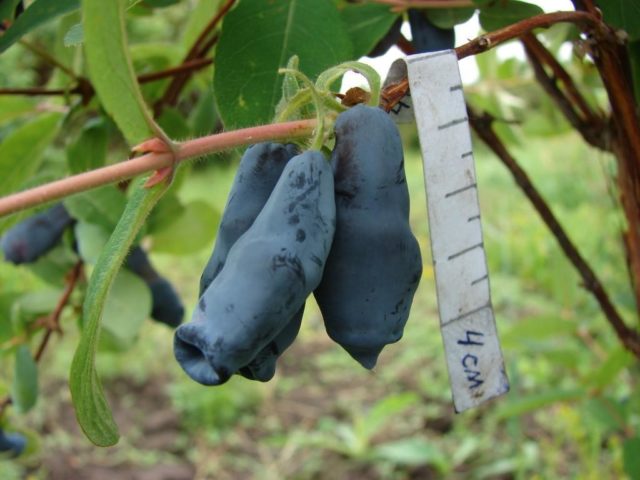
The Giant's Daughter is one of the more recent varieties with dessert qualities.
Among the advantages of the plant, one can note resistance to cold and disease and the fact that the berries do not crumble from the branches for a long time. The bush is capable of demonstrating high fruiting ability, more than 3 kg of fruit. The Giant's Daughter ripens closer to the beginning of July.
Winter hardy varieties of honeysuckle
Almost all varieties of edible honeysuckle tolerate cold weather well. But in the descriptions and on the video of the varieties of honeysuckle, special mention is made of varieties with increased resistance to frost for Siberia and the Urals.
Blue bird
In height, the plant rises by no more than 1.5 m; in adulthood, it yields a crop of medium volumes. Ripening occurs by mid-June, but at the same time, individual fruits can ripen on the branches for about a month. The berries are medium in weight and size, blue in color, with a blueberry aroma and a sweet, slightly tart taste.
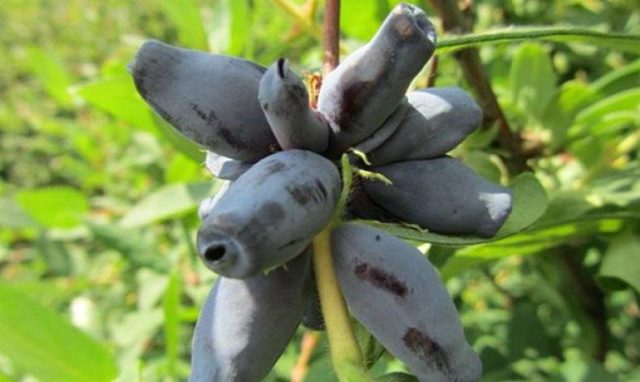
Blue Bird is well suited for cultivation in Siberia
The tasters give Blue Bird a 4.5. Honeysuckle has a high cold resistance and takes root well in Siberia at winter temperatures of about -35 ° C.
Wiliga
A tall shrub up to 2 m has a small sparse crown, ripens closer to June 30. The fruits of the Wiliga variety are dense blue, not too weighty in weight. But an adult shrub is capable of bringing up to 2.5 kg of harvest.
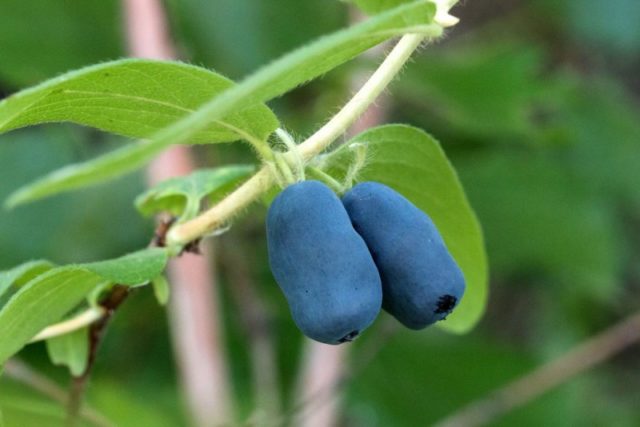
Viliga is a slightly sour and tart variety, but tastes good.
The berries have a dessert taste, there is no bitterness in it, although there is a slight sourness and astringency, which is why the variety is assigned only 4.4 points of the tasting assessment. Viliga grows well in the northern regions of the country and tolerates severe winter colds below -35 ° C.
Kamchadalka
Honeysuckle with the expressive name Kamchadalka was bred specifically for breeding in Siberia. The variety bears fruit until the end of June, it stretches in height by no more than 1.5 m. The yield at Kamchadalka is average, and ripening is uneven and spaced in time. But the variety is not prone to shedding, so you can just wait until most of the berries reach maturity.
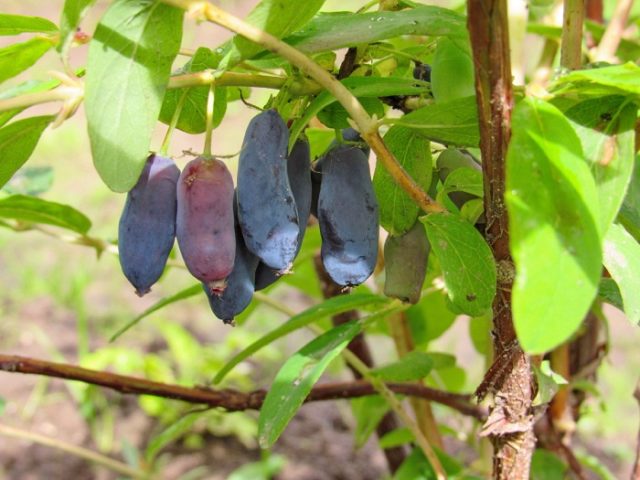
Kamchadalka is one of the most cold-resistant varieties of culture
The fruits of the shrub are blue-blue with a dense skin, oval and slightly elongated. The taste is sweet with a distinct sourness, although there is no astringency and bitterness in the pulp. The average grade is about 4.6 points.
An amazing feature of Kamchadalka is its high frost resistance, up to -50 ° C. It is possible to grow sweet honeysuckle even in the most severe climatic zones.
Conclusion
Honeysuckle varieties with descriptions give a good idea of the variety of fruit shrubs. If desired, for the garden, you can find a culture with optimal cold resistance and yield, with a dessert taste and early fruiting.








